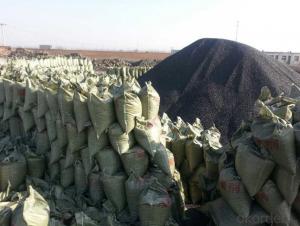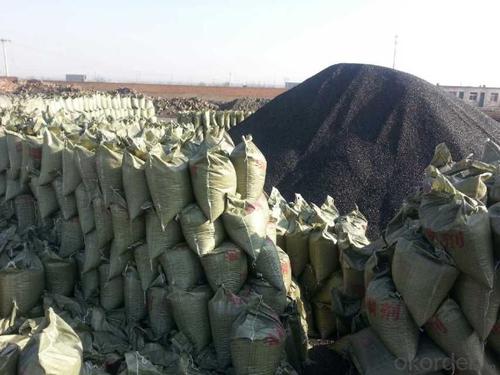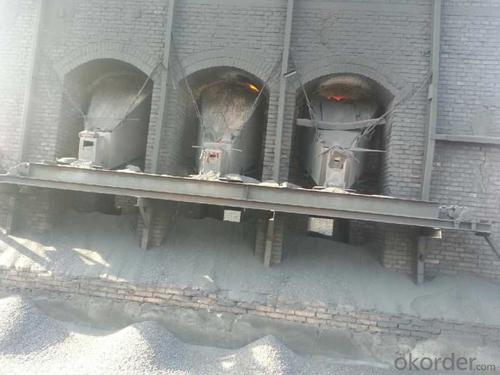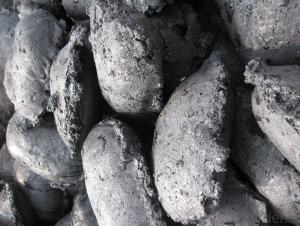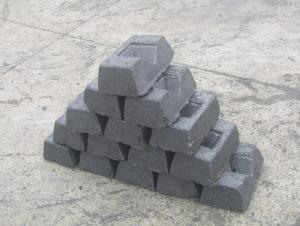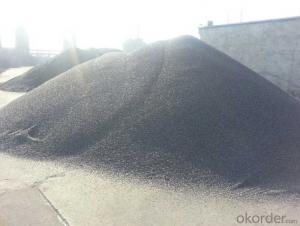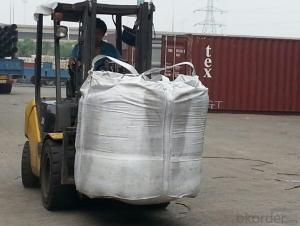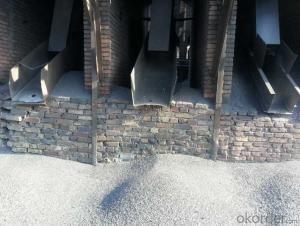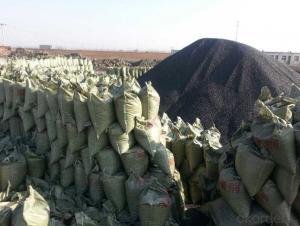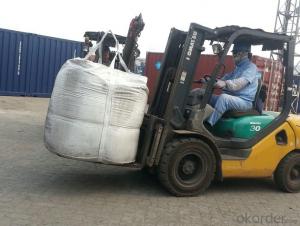Charge Coke FC80-90 with stable quality
- Loading Port:
- Tianjin
- Payment Terms:
- TT OR LC
- Min Order Qty:
- 20 m.t.
- Supply Capability:
- 3000 m.t./month
OKorder Service Pledge
OKorder Financial Service
You Might Also Like
Packaging & Delivery
25kgs/50kgs/1ton per bag or as buyer's request
Specifications
Calcined Anthracite
Fixed carbon: 90%-95%
S: 0.5% max
Size: 0-3. 3-5.3-15 or as request
It used the high quality anthracite as raw materials through high temperature calcined at over 2000 by the DC electric calciner with results in eliminating the moisture and volatile matter from anthracite efficiently, improving the density and the electric conductivity and strengthening the mechanical strength and anti-oxidation. It has good characteristics with low ash, low resistvity, low sulphur, high carbon and high density. It is the best material for high quality carbon products.
Advantage and competitive of caclined anthracite:
1. strong supply capability
2. fast transportation
3. lower and reasonable price for your reference
4.low sulphur, low ash
5.fixed carbon:95% -90%
6..sulphur:lower than 0.3%
General Specification of Calcined Anthracite:
| FC | 80 | 83 | 85 | 88 | 90 |
| ASH | 16 | 14 | 13 | 10 | 8.5 |
| V.M. | 3 | 3 | 2 | 2 | 1.5 |
| S | 0.5 | 0.5 | 0.5 | 0.5 | 0.35 |
| MOISTURE | 2 | 2 | 1 | 1 | 0.5 |
Pictures

We are also strong at below materials, please contact us if you are interested in any of them:
Calcined Petroleum Coke
Carbon Electrode Paste
Carbon Electrode
- Q: How does carbon impact the structure and function of ecosystems?
- Carbon, as a fundamental element, plays a crucial role in shaping the structure and function of ecosystems. It serves as a building block of life, found in all living organisms, and continuously cycles between the atmosphere, living organisms, and the Earth's surface. The impact of carbon on ecosystems is diverse, both directly and indirectly. To begin with, carbon is a vital component of organic matter, including plants, animals, and decomposing organic materials. It provides the necessary energy and nutrients for the growth and development of organisms. Through the process of photosynthesis, plants absorb carbon dioxide from the atmosphere and convert it into organic compounds, primarily carbohydrates. These compounds serve as a source of energy and building materials for other organisms, forming the basis of the food chain. As a result, carbon is essential for sustaining the productivity and biodiversity of organisms within ecosystems, as it contributes to their structure and functioning. Additionally, carbon influences the physical structure of ecosystems. In terrestrial ecosystems, carbon is stored in vegetation and soils, creating carbon sinks. Forests, for example, store significant amounts of carbon in their biomass and soils. This plays a crucial role in mitigating climate change by absorbing and sequestering carbon dioxide. However, the loss of these ecosystems, due to deforestation or degradation, can release large amounts of carbon back into the atmosphere. This contributes to the greenhouse effect and climate change. In marine ecosystems, carbon is stored in the form of dissolved inorganic carbon, which can affect ocean acidity. The increasing concentration of carbon dioxide in the atmosphere leads to ocean acidification, impacting the growth and survival of marine organisms, particularly those with calcium carbonate shells or skeletons, such as corals and mollusks. Furthermore, carbon influences the functioning of ecosystems through its role in nutrient cycling. Decomposition, the process of breaking down and recycling organic matter, is largely driven by microorganisms that respire carbon dioxide. This process releases essential nutrients, such as nitrogen, phosphorus, and sulfur, back into the soil, making them available for uptake by plants. Nutrient cycling is crucial for maintaining the productivity and nutrient balance within ecosystems. Changes in the availability of carbon can affect the rates of decomposition and nutrient cycling, which, in turn, impact the structure and functioning of ecosystems. In conclusion, carbon is a fundamental element that significantly impacts the structure and function of ecosystems. Its involvement in energy transfer, organic matter formation, nutrient cycling, and climate regulation makes it essential for the sustainability and functioning of all living organisms within an ecosystem. To ensure the health and resilience of ecosystems in the face of environmental changes, understanding and managing carbon dynamics is crucial.
- Q: Will long-term use of carbon alloy chopsticks cause cancer?
- The chopsticks are washed with water for a long time, and the water content is especially high. The chopsticks are placed in the non ventilated place for a long time, and the chances of deterioration of the chopsticks are improved." Huang Yahui said, especially the moldy chopsticks, may be contaminated by aflatoxin. It is understood that aflatoxin is the 1 class of carcinogens, is a highly toxic highly toxic substances, human and animal liver tissue will have a damaging effect, can lead to serious liver cancer or even death. Huang Yahui warned that the public should be weekly chopsticks into boiling water after half an hour, placed in the air to air dry before use, it can achieve the disinfection effect, and can effectively and conveniently remove mildew in chopsticks. In addition, it is best to use half a year to replace the new chopsticks, so you don't have to worry too much. "The selection of chopsticks is also very exquisite."." Huang Yahui said, "the ideal chopsticks are bamboo chopsticks and non staining wooden chopsticks.". After the dyed or painted wood, paint and stain will enter the body with food. When in use, especially the stain in heavy metals, benzene and other harmful substances, can cause gastrointestinal inflammation, ulceration, erosion, serious can cause cancer.
- Q: How do forests act as carbon sinks?
- Forests act as carbon sinks by absorbing carbon dioxide from the atmosphere through the process of photosynthesis. Trees and other plants take in carbon dioxide and convert it into oxygen, while storing the carbon in their trunks, branches, and roots. This stored carbon remains in the forest ecosystem, reducing the amount of greenhouse gases in the atmosphere and helping to mitigate climate change.
- Q: What are the consequences of increased carbon emissions on coral reefs?
- Coral reefs are severely impacted by the increased emission of carbon, resulting in numerous consequences. One major effect is the occurrence of ocean acidification, which happens when excess carbon dioxide is absorbed by seawater, causing a decrease in pH levels. This acidification hampers the ability of corals to construct their calcium carbonate skeletons, making them more susceptible to erosion and breakage. Moreover, elevated levels of carbon dioxide in the atmosphere contribute to global warming, leading to the rise of ocean temperatures. Consequently, coral bleaching occurs as corals expel the symbiotic algae responsible for their vibrant colors. Without these algae, corals become stressed, lose their color, and become more vulnerable to disease and death. Additionally, increased carbon emissions contribute to alterations in ocean currents and weather patterns, resulting in more frequent and intense storms. These storms physically damage coral reefs, causing further destruction to already fragile ecosystems. The consequences of increased carbon emissions on coral reefs are profound and devastating. The decline of coral reefs not only impacts the biodiversity of the oceans but also has significant implications for human populations that rely on reefs for sustenance, income, coastal protection, and tourism. It is imperative to reduce carbon emissions and take immediate action to safeguard and preserve these invaluable ecosystems.
- Q: What is carbon nanotechnology?
- Carbon nanotechnology involves the study and manipulation of carbon-based materials at the nanoscale, typically in the form of carbon nanotubes, fullerenes, or graphene. It focuses on harnessing the unique properties and structures of these carbon materials to develop innovative applications in various fields such as electronics, medicine, energy, and materials science.
- Q: What is latent carbon?
- Prochiral carbon atom (prochiral carbon atoms).A company has four completely different carbon atoms or groups of atoms is called chiral carbon atoms. When a carbon atom with two identical and two different atoms or groups of atoms such as Caabe, the carbon atom is called prochiral carbon atom (prochiral carbon) or prochiral center. If the two of the same atom or group of atoms (a, one of the many hydrogen atoms) is a different from a, B, e atom or group of atoms substituted by the D, get a new chiral carbon atoms such as methylene Cabed. ethanol and propionic acid molecules in the carbon atom is prochiral carbon atoms.
- Q: What are the impacts of carbon emissions on the stability of mountain glaciers?
- Carbon emissions have a significant impact on the stability of mountain glaciers. As carbon dioxide and other greenhouse gases accumulate in the atmosphere, they trap heat and contribute to global warming. This increase in temperature leads to accelerated melting of mountain glaciers, reducing their size and volume. The loss of glaciers not only affects the availability of freshwater resources but also disrupts local ecosystems, alters river flows, and poses a risk of glacial lake outburst floods. Moreover, melting glaciers contribute to rising sea levels, which can have far-reaching consequences for coastal communities and low-lying areas. Therefore, reducing carbon emissions is crucial to mitigate the adverse effects on the stability of mountain glaciers and preserve these vital natural resources.
- Q: What are the effects of carbon emissions on the stability of coastal ecosystems?
- Carbon emissions have significant negative effects on the stability of coastal ecosystems. The increased concentration of carbon dioxide in the atmosphere leads to ocean acidification, which disrupts the delicate balance of marine ecosystems. This acidity affects the growth and development of various organisms such as corals, shellfish, and other calcifying organisms, jeopardizing the health of coral reefs and shellfish populations. Additionally, rising sea levels, a result of climate change caused by carbon emissions, threaten coastal habitats, including wetlands and mangroves, which serve as critical nurseries and protective buffers against storms. Overall, carbon emissions contribute to the degradation and vulnerability of coastal ecosystems, compromising their stability and the services they provide to both marine life and human communities.
- Q: What is the role of carbon in photosynthesis?
- The role of carbon in photosynthesis is to serve as the building block for glucose, the main energy source for plants. Carbon dioxide (CO2) is captured during photosynthesis and converted into glucose through a series of chemical reactions. This process, known as carbon fixation, is essential for plants to produce food and release oxygen into the atmosphere.
- Q: How is carbon dating used to determine the age of fossils?
- Carbon dating is a scientific method used to determine the age of fossils and other organic materials. It relies on the fact that carbon-14, an isotope of carbon, is present in the atmosphere and taken up by living organisms while they are alive. Once an organism dies, it no longer takes in carbon-14 and the amount of this isotope begins to decrease over time as it undergoes radioactive decay. To determine the age of a fossil using carbon dating, scientists first extract a small sample of the fossil. This sample is then treated with chemicals to remove any contaminants and extract the carbon from the organic material. The extracted carbon is then converted into carbon dioxide gas, which is used to create graphite targets for measuring the levels of carbon-14. Scientists use a technique called Accelerator Mass Spectrometry (AMS) to count the number of carbon-14 and carbon-12 atoms in the sample. The ratio of carbon-14 to carbon-12 is then used to calculate the age of the fossil, based on the known half-life of carbon-14, which is approximately 5730 years. By comparing the amount of carbon-14 remaining in the fossil to the amount of carbon-14 in the atmosphere at the time the organism died, scientists can determine the approximate age of the fossil. This method is particularly useful for dating organic materials up to about 50,000 years old. For older fossils, other methods such as potassium-argon dating or uranium-lead dating are typically used.
Send your message to us
Charge Coke FC80-90 with stable quality
- Loading Port:
- Tianjin
- Payment Terms:
- TT OR LC
- Min Order Qty:
- 20 m.t.
- Supply Capability:
- 3000 m.t./month
OKorder Service Pledge
OKorder Financial Service
Similar products
Hot products
Hot Searches
Related keywords
